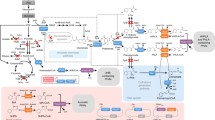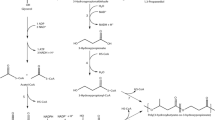Abstract
Oxidized polyvinyl alcohol (PVA) hydrolase (OPH) is a key enzyme in the degradation of PVA, suggesting that OPH has a great potential for application in textile desizing processes. In this study, the OPH gene from Sphingopyxis sp. 113P3 was modified, by artificial synthesis, for overexpression in Escherichia coli. The OPH gene, lacking the sequence encoding the original signal peptide, was inserted into pET-20b (+) expression vector, which was then used to transform E. coli BL21 (DE3). OPH expression was detected in culture medium in which the transformed E. coli BL21 (DE3) was grown. Nutritional and environmental conditions were investigated for improved production of OPH protein by the recombinant strain. The highest OPH activity measured was 47.54 U/mL and was reached after 84 h under optimal fermentation conditions; this level is 2.64-fold higher that obtained under sub-optimal conditions. The productivity of recombinant OPH reached 565.95 U/L/h. The effect of glycine on the secretion of recombinant OPH was examined by adding glycine to the culture medium to a final concentration of 200 mM. This concentration of glycine reduced the fermentation time by 24 h and increased the productivity of recombinant OPH to 733.17 U/L/h. Our results suggest that the recombinant strain reported here has great potential for use in industrial applications.




Similar content being viewed by others
References
Carri M, Villaverde A (2003) Role of molecular chaperones in inclusion body formation. FEBS Lett 537:215–221
Eiteman MA, Altman E (2006) Overcoming acetate in Escherichia coli recombinant protein fermentations. Trends Biotechnol 24:530–536
Fink A (1998) Protein aggregation: folding aggregates, inclusion bodies and amyloid. Fold Des 3:R9–R23
Gething M, Sambrook J (1992) Protein folding in the cell. Nature 355:33–45
Hashimoto S, Fujita M (1985) Isolation of a bacterium requiring three amino acids for polyvinyl alcohol degradation. J Ferment Technol 63:471–474
Hatanaka T, Asahi N, Tsuji M (1995) Purification and characterization of poly (vinyl alcohol) dehydrogenase from Pseudomonas sp. 113P3. Biosci Biotechnol Biochem 59:1813–1816
Hirota-Mamoto R, Nagai R, Tachibana S, Yasuda M, Tani A, Kimbara K, Kawai F (2006) Cloning and expression of the gene for periplasmic poly(vinyl alcohol) dehydrogenase from Sphingomonas sp strain 113P3, a novel-type quinohaemoprotein alcohol dehydrogenase. Microbiology 152:1941–1949
Hu XP, Mamoto R, Fujioka Y, Tani A, Kimbara K, Kawai F (2008) The pva operon is located on the megaplasmid of Sphingopyxis sp strain 113P3 and is constitutively expressed, although expression is enhanced by PVA. Appl Microbiol Biotechnol 78:685–693
Kaderbhai N, Karim A, Hankey W, Jenkins G, Venning J, Kaderbhai M (1997) Glycine-induced extracellular secretion of a recombinant cytochrome expressed in Escherichia coli. Biotechnol Appl Biochem 25:53–61
Kawagoshi Y, Fujita M (1998) Purification and properties of the polyvinyl alcohol-degrading enzyme 2, 4-pentanedione hydrolase obtained from Pseudomonas vesicularis var. povalolyticus pH. World J Microbiol Biotechnol 14:95–100
Kawai F, Hu XP (2009) Biochemistry of microbial polyvinyl alcohol degradation. Appl Microbiol Biotechnol 84:227–237
Klomklang W, Tani A, Kimbara K, Mamoto R, Ueda T, Shimao M, Kawai F (2005) Biochemical and molecular characterization of a periplasmic hydrolase for oxidized polyvinyl alcohol from Sphingomonas sp strain 113P3. Microbiology 151:1255–1262
Mamoto R, Hu XP, Chiue H, Fujioka Y, Kawai F (2008) Cloning and expression of soluble cytochrome c and its role in polyvinyl alcohol degradation by polyvinyl alcohol-utilizing Sphingopyxis sp strain 113P3. J Biosci Bioeng 105:147–151
Mukhopadhyay A (1997) Inclusion bodies and purification of proteins in biologically active forms. Adv Biochem Eng Biotechnol 56:61–109
Nord F (1936) Dehydrogenation activity of Fusarium lini B. Naturwissschaften 24:763
Rhee J, Bode J, Diaz-Ricci J, Poock D (1997) Influence of the medium composition and plasmid combination on the growth of recombinant Escherichia coli JM109 and on the production of the fusion protein EcoRI: SPA. J Biotechnol 55:69–83
Sakai K, Hamada N, Watanabe Y (1984) Non-enzymatic degradation of secondary alcohol oxidase-oxidized poly (vinyl alcohol). Agric Biol Chem 48:1093–1095
Sakai K, Hamada N, Watanabe Y (1985) Purification and properties of secondary alcohol oxidase with an acidic isoelectric point. Agric Biol Chem 49:817–825
Sakazawa C, Shimao M, Taniguchi Y, Kato N (1981) Symbiotic utilization of polyvinyl alcohol by mixed cultures. Appl Environ Microbiol 41:261–267
Sharp P, Li W (1987) The codon adaptation index-a measure of directional synonymous codon usage bias, and its potential applications. Nucleic Acids Res 15:1281–1295
Shimao M, Ninomiya K, Kuno O, Kato N, Sakazawa C (1986) Existence of a novel enzyme, pyrroloquinoline quinone-dependent polyvinyl alcohol dehydrogenase, in a bacterial symbiont, Pseudomonas sp. strain VM15C. Appl Environ Microbiol 51:268–275
Shimao M, Tamogami T, Kishida S, Harayama S (2000) The gene pvaB encodes oxidized polyvinyl alcohol hydrolase of Pseudomonas sp. strain VM15C and forms an operon with the polyvinyl alcohol dehydrogenase gene pvaA. Microbiology 146:649–657
Shimao M, Tamogami T, Nishi K, Harayama S (1996) Cloning and characterization of the gene encoding pyrroloquinoline quinone-dependent poly (vinyl alcohol) dehydrogenase of Peudomonas sp. strain VM15C. Biosci Biotechnol Biochem 60:1056–1062
Suzuki T (1976) Purification and some properties of polyvinyl alcohol degrading enzyme produced by Pseudomonas O-3. Agric Biol Chem 40:497–504
Takeuchi M, Hamana K, Hiraishi A (2001) Proposal of the genus Sphingomonas sensu stricto and three new genera, Sphingobium, Novosphingobium and Sphingopyxis, on the basis of phylogenetic and chemotaxonomic analyses. Int J Syst Evol Microbiol 51:1405–1417
Tang J, Yang H, Song S, Zhu P, Ji A (2008) Effect of glycine and Triton X-100 on secretion and expression of ZZ-EGFP fusion protein. Food Chem 108:657–662
Watanabe Y, Morita M, Hamada N, Tsujisaka Y (1975) Formation of hydrogen peroxide by a polyvinyl alcohol degrading enzyme. Agric Biol Chem Jpn 39:2447–2448
Yamatsu A, Matsumi R, Atomi H, Imanaka T (2006) Isolation and characterization of a novel poly (vinyl alcohol)-degrading bacterium, Sphingopyxis sp. PVA3. Appl Microbiol Biotechnol 72:804–811
Zhang D, Wang M, Du G, Zhao Q, Wu J, Chen J (2008) Surfactant protein of the Streptomyces subtilisin inhibitor family inhibits transglutaminase activation in Streptomyces hygroscopicus. J Agric Food Chem 56:3403–3408
Acknowledgments
This study was financially supported by the Program for New Century Excellent Talents in University (NCET-07-0378), the Key Program of National Natural Science Foundation of China (No. 20836003), the Major State Basic Research Development Program of China (973 Program, No. 2007CB714306) and the Priority Academic Program Development of Jiangsu Higher Education Institution.
Author information
Authors and Affiliations
Corresponding authors
Rights and permissions
About this article
Cite this article
Yang, Y., Zhang, D., Liu, S. et al. Expression and fermentation optimization of oxidized polyvinyl alcohol hydrolase in E. coli . J Ind Microbiol Biotechnol 39, 99–104 (2012). https://doi.org/10.1007/s10295-011-1004-x
Received:
Accepted:
Published:
Issue Date:
DOI: https://doi.org/10.1007/s10295-011-1004-x




